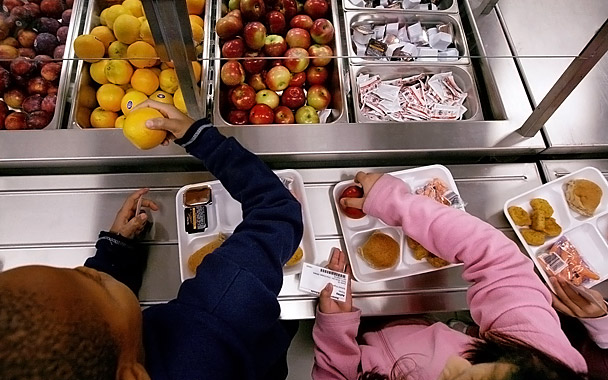Secretary of Agriculture Tom Vilsack told reporters last week that the Obama Administration intended to use money saved by cutting “direct payments” to wealthy farmers to increase the budget for nutrition programs, including the massive school lunch program.
A new commitment to childhood nutrition, coupled with the re-authorization of the School Lunch Program this year, will increase the opportunity to implement a little-known provision in the Farm Bill that encourages schools to use “local preference” to purchase fresh food from local farmers rather than relying on huge national commodity-distribution companies. It seems like a win-win proposition. What could be healthier for students or more economically sensible for farmers than connecting farmers directly to local schools?
JoAnne Berkenkamp and her colleagues at the Institute for Agriculture and Trade Policy have discovered that the proverbial devil is in the details. Last fall, Berkenkamp teamed up with the Minnesota School Nutrition Association to survey school food-service directors about their interest in direct farm-to-school marketing. Sixty-nine Minnesota school districts responded. They were overwhelmingly enthusiastic, but also cautious.
One of the biggest problems is that school districts depend on large, steady supplies of pre-cooked food. That’s why institutional distributors play such a big role in school lunch programs. “What’s available when is a big problem,” Berkenkamp explains. “Many school kitchens aren’t set up to handle the whole foods that come directly off of farms at harvest time. Uncut carrots, whole potatoes, whole chickens, even husking corn and cutting it into correct portions present problems for small, understaffed school kitchens.” Those little realities guarantee that distributors will have a role to play in the purchasing and pre-preparation of food, and in guaranteeing that foods meet sanitation standards. “The safety issue has been elevated in recent years,” Berkenkamp warns. “There’s not much forgiveness for food that makes children sick.”
To make direct farm-to-school programs work, schools will need to deal with the challenges of seasonal availability and limited supplies. The Minnesota Department of Agriculture has developed a “Minnesota Grown” chart that explains what is grown in the state, and Berkenkamp is developing training sessions to teach food-service staffs how and when to introduce those foods into school menus. September through December is a good time for apples, corn, onions, carrots, potatoes, beets, and squash. “Who would have thought that kids would eat butternut squash or winter roast vegetable mixes? But they do,” she says. Winter, on the other hand, is tough, a time in which distributors backfill with commodity foods from all over the world.
One of the most curious results of the survey was that a large percentage of school food-service administrators wanted greater access to local fruits and vegetables, but in the heart of dairy and beef country, almost no one was interested in local meat or dairy products. “We’re going to work on that,” Berkenkamp says. She attributes the lack of interest to the fact that meats are more expensive and harder to handle.
Working with the Minnesota School Nutrition Association, Berkenkamp is using this school year to train food-service staff, develop seasonal recipes, improve facilities, build a network of farmers to participate in the program, and encourage more school districts to become active. Schools are already planning their school lunch budgets for next year, when she expects to see a big jump in farm-to-school contracts.




 Pinterest
Pinterest


